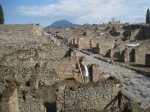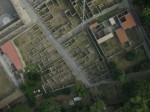 A multi-year University of Cincinnati excavation of two city blocks in the shadow of the busy Porta Stabia gate has revealed an unexpected variety of foods from cheap local forage like nuts to expensive imported meats like giraffe leg. The team studied artifacts discovered at Insula VIII.7.1-15 and Insula I.1 during the 19th and early 20th century excavations, tracking them all down in various museums and adding them to a database, and excavated waste collected in drains, latrines and cesspits. The kitchen discards and mineralized excrement provide a direct window into the diets of the middle and lower classes who frequented and lived in the neighborhood.
A multi-year University of Cincinnati excavation of two city blocks in the shadow of the busy Porta Stabia gate has revealed an unexpected variety of foods from cheap local forage like nuts to expensive imported meats like giraffe leg. The team studied artifacts discovered at Insula VIII.7.1-15 and Insula I.1 during the 19th and early 20th century excavations, tracking them all down in various museums and adding them to a database, and excavated waste collected in drains, latrines and cesspits. The kitchen discards and mineralized excrement provide a direct window into the diets of the middle and lower classes who frequented and lived in the neighborhood.
Adjacent to the Large Theater, the Triangular forum, the Covered Theater and the Quadroporticus (probably an open air gymnasium), by the time of the 79 A.D. eruption of Vesuvius that sealed the city’s doom, the two insulae included 10 building plots and 20 shop fronts. They were in the heart of the city’s entertainment district, a bustling area for the hospitality and food trades with a lot of foot traffic from the Porta Stabia, Pompeii’s oldest gate. Indeed, excavations discovered evidence of very old buildings in the center of Insula VIII.7 dating back as far as the 4th century B.C. when they appear to have been dedicated to industrial use. This was small scale stuff, cottage industries, basically. Most of them appear to have been salted fish operations, although one tannery was unearthed, a significant find since it’s only the second tannery ever discovered at Pompeii.
 A gap in the record after the 4th century B.C. suggests the area (other parts of Pompeii have the same gap) was abandoned only to resume bustling in the mid-2nd century B.C. with the untrammeled rise of Roman control after the Third Punic War. The Porta Stabia neighborhood saw a major revival in the early 1st century A.D. The factories were demolished and floors and walls built over them. The small-scale industry was replaced by retail operations, storefronts and restaurants, to cater to the crowds in the neighborhood to see a show or traveling through the gate. Not all storefronts and restaurants are created equal, however, and there were big differences in quality and expense of products from one shop to then next.
A gap in the record after the 4th century B.C. suggests the area (other parts of Pompeii have the same gap) was abandoned only to resume bustling in the mid-2nd century B.C. with the untrammeled rise of Roman control after the Third Punic War. The Porta Stabia neighborhood saw a major revival in the early 1st century A.D. The factories were demolished and floors and walls built over them. The small-scale industry was replaced by retail operations, storefronts and restaurants, to cater to the crowds in the neighborhood to see a show or traveling through the gate. Not all storefronts and restaurants are created equal, however, and there were big differences in quality and expense of products from one shop to then next.
“The material from the drains revealed a range and quantity of materials to suggest a rather clear socio-economic distinction between the activities and consumption habits of each property, which were otherwise indistinguishable hospitality businesses,” says [University of Cincinnati associate professor of classics Steven] Ellis. Findings revealed foods that would have been inexpensive and widely available, such as grains, fruits, nuts, olives, lentils, local fish and chicken eggs, as well as minimal cuts of more expensive meat and salted fish from Spain. Waste from neighboring drains would also turn up less of a variety of foods, revealing a socioeconomic distinction between neighbors.
A drain from a central property revealed a richer variety of foods as well as imports from outside Italy, such as shellfish, sea urchin and even delicacies including the butchered leg joint of a giraffe.
“That the bone represents the height of exotic food is underscored by the fact that this is thought to be the only giraffe bone ever recorded from an archaeological excavation in Roman Italy,” says Ellis. “How part of the animal, butchered, came to be a kitchen scrap in a seemingly standard Pompeian restaurant not only speaks to long-distance trade in exotic and wild animals, but also something of the richness, variety and range of a non-elite diet.”
Deposits also included exotic and imported spices, some from as far away as Indonesia.
 I love these kinds of studies because a) ancient poop is awesome, and b) because they underscore how wide-reaching the improved standard of living was for people in the Roman Empire. There were haves and have-nots to a huge degree, of course, what with the vast heaving mass of slaves underpinning the economy, but you didn’t have to be rich to have access to expensive delicacies like giraffe leg and imported Spanish fish. Trade networks and mass production allowed regular people to live with day-to-day comforts like a constant supply of staples (olive oil, bread, bacteria-fermented fish intestine sauce aka garum), lamps, roof tiles and weird takeout.
I love these kinds of studies because a) ancient poop is awesome, and b) because they underscore how wide-reaching the improved standard of living was for people in the Roman Empire. There were haves and have-nots to a huge degree, of course, what with the vast heaving mass of slaves underpinning the economy, but you didn’t have to be rich to have access to expensive delicacies like giraffe leg and imported Spanish fish. Trade networks and mass production allowed regular people to live with day-to-day comforts like a constant supply of staples (olive oil, bread, bacteria-fermented fish intestine sauce aka garum), lamps, roof tiles and weird takeout.
Easy explanation would be a giraffe died in transit to being used in the games and was sold off to a butcher for disposal. I would imagine given the death rate of wild animals in transit odd meats might be fairly common, though perhaps not a whole limb with bone in, I would imagine it parted out more frequently [how often would the average family need 20 kilos of meat, perhaps for a Saturnalia gathering of a bunch?] If not used by the single family, perhaps someone bought the whole leg with an eye towards reselling cuts to neighbors.
I would be willing to bet that if the analysis were done, the fecal remnants would show a fairly wide range of exotic meat that was purchased that had no bones in it. A small steak of 250 grams could be sold for a fairly reasonable sum if it were because of dead animal disposal. I can not see the importer hauling a dead animal up to Rome to be fed to the other animals.